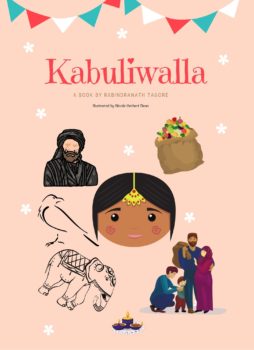Afghans Among Us – Kabuliwallas Posted by Nicole Herbert Dean on May 23, 2021 in Culture, Travel & Geography
Afghans Among Us
I recently created बनाया a children’s workbook based on a favorite childhood बचपन story called Kabuliwalla. Rabindranath Tagore wrote this story कहानी in the year 1892. The story is about an Afghan who used to sell dried fruit सूखे फल बेचना and nuts on the streets of Calcutta. Natives of Calcutta or Kolkatta as its known today, called these Afghan fruit sellers, Kabuliwalla काबुलीवाला.
Kabul, is the capital of Afghanistan and ‘walla’ a common आम Hindi adjectival suffix, in this context referring to the person व्यक्ति.
History of the Afghans in India
I started researching how कैसा and why क्यों Tagore came to write this story and stumbled upon an interesting history of the Afghans in India. I remember seeing Afghans in Mumbai as a young child.
Afghans have lived रहते थे in Calcutta for many years although यद्यपि their numbers are dwindling. They first came to Calcutta in 1839 soon after the Anglo-Afghan wars. Afghans are also called Pathans पठानों because they came from Pashtunistan. They traveled via Kandahar – Quetta on the Southern land route मार्ग. Most sold fruit and nuts door to door. These tall imposing भव्य men in their long loose tunics and baggy pants, left their families परिवारों behind and traveled for months around India.
In 1947 when India gained Independence अनधीनता from the British, many of the Afghans traveling in India found it difficult कठिन to go back home. Many remained in Calcutta because the city welcomed स्वागत them. Because they would travel alone अकेला they married Indian women. Although they were open to marriage with Indians they fiercely जमकर retained their Afghan identity.
Lifestyle, Customs and Culture
They brought with them their customs and traditions रीति-रिवाज और परंपराएं which are tribal in nature with strict secretive codes गुप्त संहिताएं. They speak Pashto and celebrate मनाना Eid just like they would back home, eating together on dastarkhans. The Pathans adopted अपनाया India as their home. They use the term मुल्क which means native country when referring to India.
These Kabuliwallas live in what is known as Khan Kothis. There are still about 200 Khan Kothis in Kolkatta today – retaining their simplicity सादगी and minimalistic décor. The lifestyle जीवन-शैली of the Pathans is also quite simple. They dine on the dastarkhwans, love flying kites पतंग उड़ाते हुए at the maidans around Calcutta and performing प्रदर्शन the Pashtun Attan dance. They also have ‘anda kushti’ which are hard-boiled egg fights.
Today the Kabuliwalla’s means of livelihood रोज़ी includes money lending and other trades besides selling dried fruit and nuts.
Disparities and Inequalities असमानता do not deter their love
In today’s India, they do not enjoy the same privileges विशेषाधिकार as other Indians. Many do not possess simple Indian documents दस्तावेज़ such as a passport or an Aadhar card – an Indian document much needed for important transactions लेनदेन such as buying a house.
When you ask them if they ever want to go back to Afghanistan, many reply that they would not despite के बावजूद their love for the land of their birth. This is because they enjoy the freedom स्वतंत्रता, better living conditions रहन-सहन की स्थिति and ease in making a livelihood in India.

Build vocabulary, practice pronunciation, and more with Transparent Language Online. Available anytime, anywhere, on any device.




